
A trestle bridge is a bridge composed of a number of short spans supported by closely spaced frames. A trestle is a rigid frame used as a support, historically a tripod used to support a stool or a pair of isosceles triangles joined at their apices by a plank or beam such as the support structure for a trestle table. Each supporting frame is a bent. A trestle differs from a viaduct in that viaducts have towers that support much longer spans and typically have a higher elevation.

The Cumbres and Toltec Scenic Railroad, often abbreviated as the C&TSRR, is a 3 ft narrow-gauge heritage railroad that operates on 64 miles (103 km) of track between Antonito, Colorado, and Chama, New Mexico, in the United States. The railroad is named for two geographical features along the route: the 10,015-foot (3,053 m)-high Cumbres Pass and the Toltec Gorge. Originally part of the Denver and Rio Grande Western Railroad's narrow-gauge network, the line has been jointly owned by the states of Colorado and New Mexico since 1970. Today, the C&TSRR is one of only two remaining parts of the former D&RGW narrow-gauge network, the other being the Durango and Silverton Narrow Gauge Railroad (D&SNG), which runs between the communities of Durango and Silverton, Colorado. The railroad has a total of ten narrow-gauge steam locomotives and two narrow-gauge diesel locomotives on its current roster. The railroad also operates two smaller former D&RGW steam locomotives, Nos. 315 and 168, for special events.

The Government Bridge or Arsenal Bridge spans the Mississippi River, connecting Rock Island, Illinois and Davenport, Iowa. The Iowa Interstate Railroad uses the upper deck of the bridge for its ex-Chicago and Rock Island Railroad route between Council Bluffs, Iowa and Chicago, Illinois. The lower deck carries automobile traffic between the two cities. It is located near Upper Mississippi Mile Marker 483, adjacent to the Mississippi River Lock and Dam No. 15. The current structure is the fourth at this location. The bridges all were built with a swing section to accommodate traffic navigating the river.
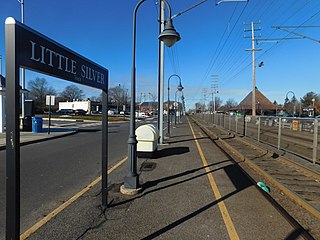
Little Silver is a railway station in Little Silver, Monmouth County, New Jersey, United States. It is served by trains on NJ Transit's North Jersey Coast Line. The station is located in between two grade crossings, and trains can back up traffic when they stop at the station.

Winona station, formerly known as the Chicago. Milwaukee & St. Paul Railway Station, is a historic train station in Winona, Minnesota, United States. It is served by Amtrak's daily Empire Builder service. It was originally built in 1888 by the Chicago, Milwaukee, St. Paul and Pacific Railroad, known later as the Milwaukee Road. A former Milwaukee Road freight house also exists here.
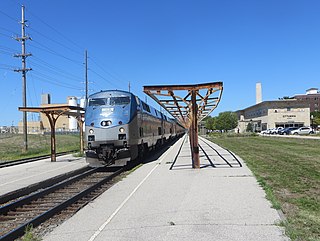
Ottumwa station is an Amtrak intercity train station in Ottumwa, Iowa, United States. The station was originally built by the Chicago, Burlington and Quincy Railroad, and has been listed as Burlington Depot by the National Register of Historic Places since November 26, 2008. It became a contributing property in the Historic Railroad District in 2011.

The Pile–Pontoon Railroad Bridge was a floating bridge which crossed the Mississippi River in northern Iowa.

The Village of East Davenport, also known simply as The Village, is located along the Mississippi River on the southeast side of Davenport, Iowa, United States. It was listed as a historic district on the National Register of Historic Places in 1980 as the Davenport Village. At the time of its nomination it included 145 contributing properties, most of which were working-class housing.
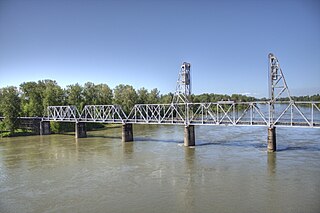
The Union Street Railroad Bridge is a vertical lift, Pratt through truss bridge that spans the Willamette River in Salem, Oregon, United States, built in 1912–13. It was last used by trains in the early 1990s and was sold for one dollar in 2003 to the City of Salem, which converted it to bicycle and pedestrian use in 2008–2009. It was added to the National Register of Historic Places in 2006.

The Rosalia Railroad Bridge was built by the Chicago, Milwaukee, St. Paul and Pacific Railroad in 1915 to replace an earlier timber trestle. The bridge was designed as a concrete arch, unusual for a railroad bridge, because it crosses the Northern Pacific Railroad tracks, a state highway, and is visible from Steptoe Battlefield State Park. The railroad wanted an impressive-looking bridge. The viaduct consists of two spans, separated by an embankment. East of the 334-foot (102 m) embankment there is a 114-foot (35 m) span crossing over the Northern Pacific tracks. To the west is a 502-foot (153 m) span that crosses Pine Creek, railroad tracks, and the highway.

The West James Street Overpass is a historic bridge in Redfield, Arkansas. It carries West James Street across the Union Pacific railroad tracks near the center of the community. It is a timber trestle structure, with six spans over a total length of 131 feet (40 m), a deck width of 20 feet (6.1 m), and an overall width of 26 feet (7.9 m). Its abutments are a combination of wood and concrete, and the posts supporting the trestles are mounted on concrete footings. It was built in 1924. The bridge was listed on the National Register of Historic Places in 1995.

CM and StP Railroad Underpass is a historic structure located southwest of Washington, Iowa, United States. It was listed on the National Register of Historic Places in 1998. The Warren deck truss bridge is a rare example of this type of bridge in Iowa, and the oldest still in existence. Given the relatively flat nature of Iowa's rivers and streams this bridge type was rarely built in the state, and was mostly built for railroad use. This bridge, completed in 1903 by the Chicago, Milwaukee, St. Paul & Pacific Railroad, crosses a county highway bridge and the west fork of Crooked Creek.

The Chicago, Milwaukee & St. Paul Depot-Jefferson, also known simply as the Milwaukee Depot is an historic building located in Jefferson, Iowa, United States. The rail line that this station served was built by the Wabash, St. Louis and Pacific Railway in either 1882 or 1883. It was part of the 500 miles (800 km) of track developed by Jay Gould in Iowa. Known as the High Bridge Route because of the height of the bridge over the Des Moines River, it was acquired by the Des Moines, Northern and Western Railroad in 1891. Four years later the Chicago, Milwaukee and St. Paul Railway acquired the line. The Milwaukee Road built this train station from their standard building plan between 1906 and 1909. It is almost identical to the station built in 1906 in Adel, Iowa. This passenger station replaced a combination passenger and freight depot that was moved and used solely as a freight depot. The Milwaukee Road discontinued passenger service in Jefferson in the early 1950s, and the depot continued as a freight office until 1980. The building was listed on the National Register of Historic Places in 1994.
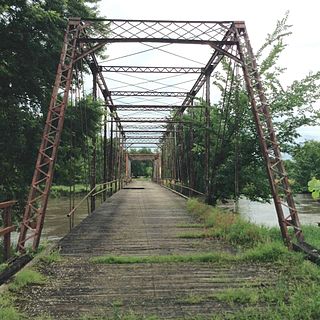
The Chambers Ford Bridge is located southeast of Chelsea, Iowa, United States. It spans the Iowa River for 345 feet (105 m). The Tama County Board of Supervisors approved a petition to construct a bridge at Chambers Ford under the condition that the local residents to secure the right-of-way for the bridge, build the trestle work and all approaches to the bridge. The Clinton Bridge and Iron Works of Clinton, Iowa built a single-span, pin-connected Pratt truss in 1890. By the turn of the 20th century the north end of the timber trestle approach that the local citizens constructed deteriorated beyond repair. The county contracted with the George King Bridge Company of Des Moines for $3,987 to build a new Pratt through truss. It was listed on the National Register of Historic Places in 1998. The bridge has been closed since 2007
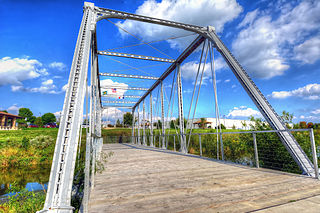
The Dunleith and Dubuque Bridge, also known as the White Water Creek Bridge and the Bergfeld Recreation Area Bridge, is a historic structure located in Dubuque, Iowa, United States. This span was part of a seven-span approach to one of the first bridges constructed over the Mississippi River. It was part of a railroad bridge that connected Dubuque with Dunleith, Illinois, now known as East Dubuque. The bridge was fabricated by the Keystone Bridge Company of Pittsburgh, Pennsylvania. Andrew Carnegie himself traveled to Dubuque to advocate for his company to build the bridge. The bridge was erected by Reynolds, Saulpaugh and Company of Rock Island, Illinois. The approach, of which this iron truss was a part, was completed in 1872. It was used by the Illinois Central and other railroads.

The Dubuque Freight House is a historic building located in Dubuque, Iowa, United States. Built by the Chicago, Burlington and Northern Railroad (CB&N) in 1901, this was the third and last freight house built by a railroad in the Ice Harbor area. The other two facilities were built by the Illinois Central Railroad (1872) and the Chicago, Milwaukee and St. Paul Railroad (1874). These other two railroads were older, larger, and monopolized the bridge and tunnel that crossed the Mississippi River. The CB&N was fortunate that their freight house was located along the water's edge in that the river boats could tie up next to the building and load and unload cargo, and the railroad put box cars on ferries that docked in the Ice Harbor. The Dubuque Boat and Boiler Works were headquartered on the west end of the facility for 20 years beginning in 1952. Founded in 1852 as the Iowa Iron Works, they provided engines, boilers and other equipment for river boats, and water craft for the United States Navy, United States Coast Guard, and the United States Army Corps of Engineers. The building was listed on the National Register of Historic Places in 1979. It is now a part of the National Mississippi River Museum & Aquarium.
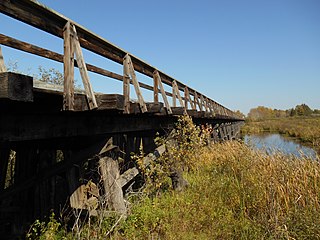
The Minnesota and International Railway Trestle at Blackduck in Beltrami County, Minnesota was the longest timber trestle in the state. It was built in 1901 and 1902 by the Minnesota and International Railway, a subsidiary of the Northern Pacific Railroad, on a line between Koochiching and Bemidji, Minnesota, where it met a branch line of the parent railroad running north from Brainerd. The bridge carried the railroad over Coburn Creek and a difficult marsh in Blackduck and was noted for its considerable length and intact substructure when it was added to the National Register of Historic Places 2014.
The Milwaukee Railroad Shops Historic District, also known as the Sioux City Railroad Museum is a nationally recognized historic district located in Sioux City, Iowa, United States. It was listed on the National Register of Historic Places in 2018. At the time of its nomination it contained 41 resources, which included six contributing buildings, 16 archaeological sites, six contributing structures, and 14 contributing objects.
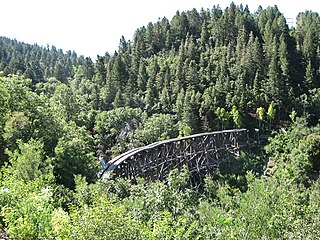
Mexican Canyon Trestle is a historic wooden trestle bridge in New Mexico's Sacramento Mountains, Otero County, New Mexico, just outside Cloudcroft, New Mexico. It was listed on the National Register of Historic Places in 1979.

The Third Street Railroad Trestle is a historic wooden railroad trestle bridge crossing Shoal Creek in downtown Austin, Texas. Built around 1922 by the International–Great Northern Railroad, it replaced an earlier bridge in the same place. The bridge was used by the I–GN Railroad, the Missouri Pacific Railroad, and the Missouri–Kansas–Texas Railroad until 1964, when commercial rail traffic stopped; after 1991 the bridge was abandoned. It was added to the National Register of Historic Places in 2021.





















